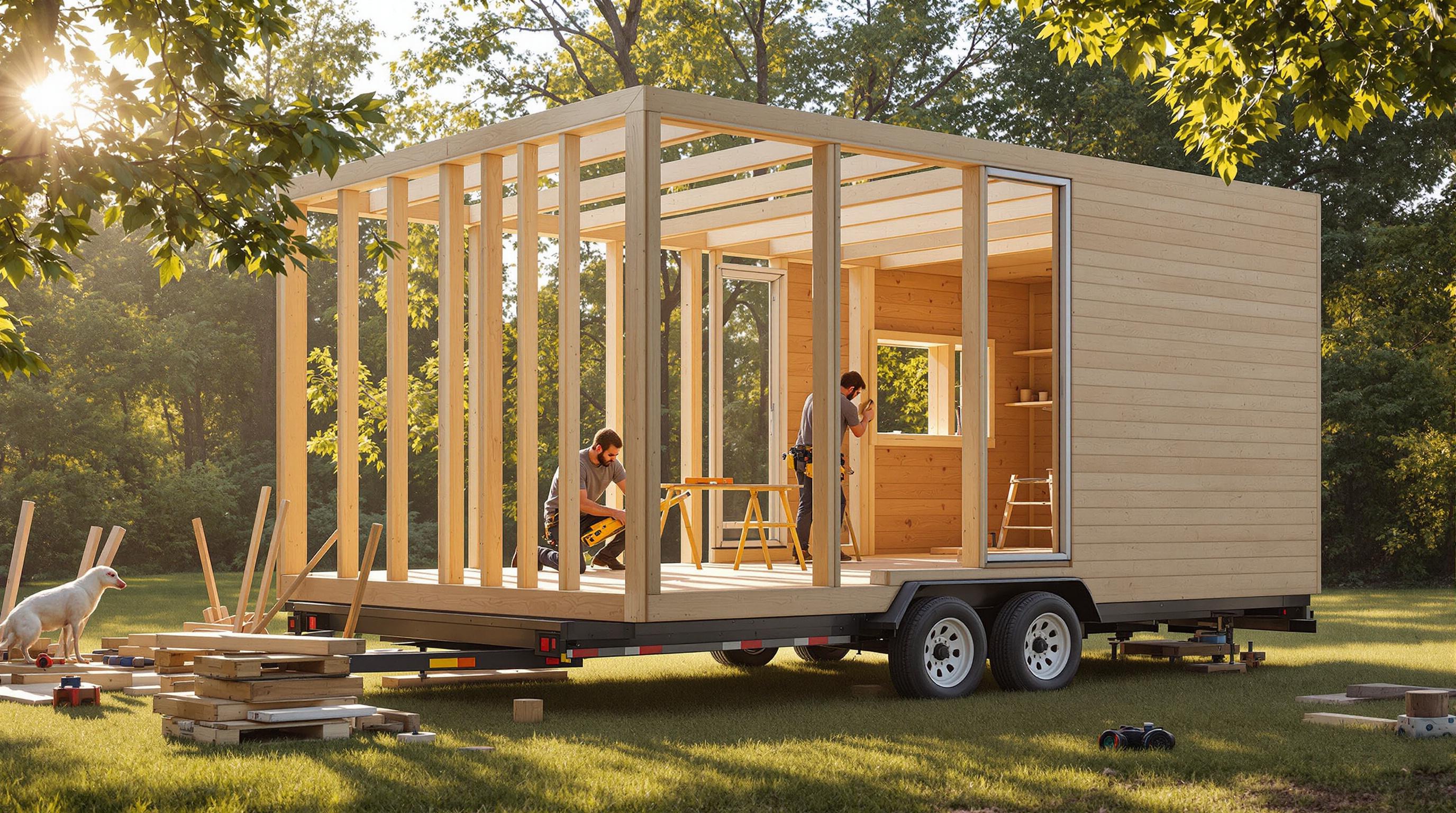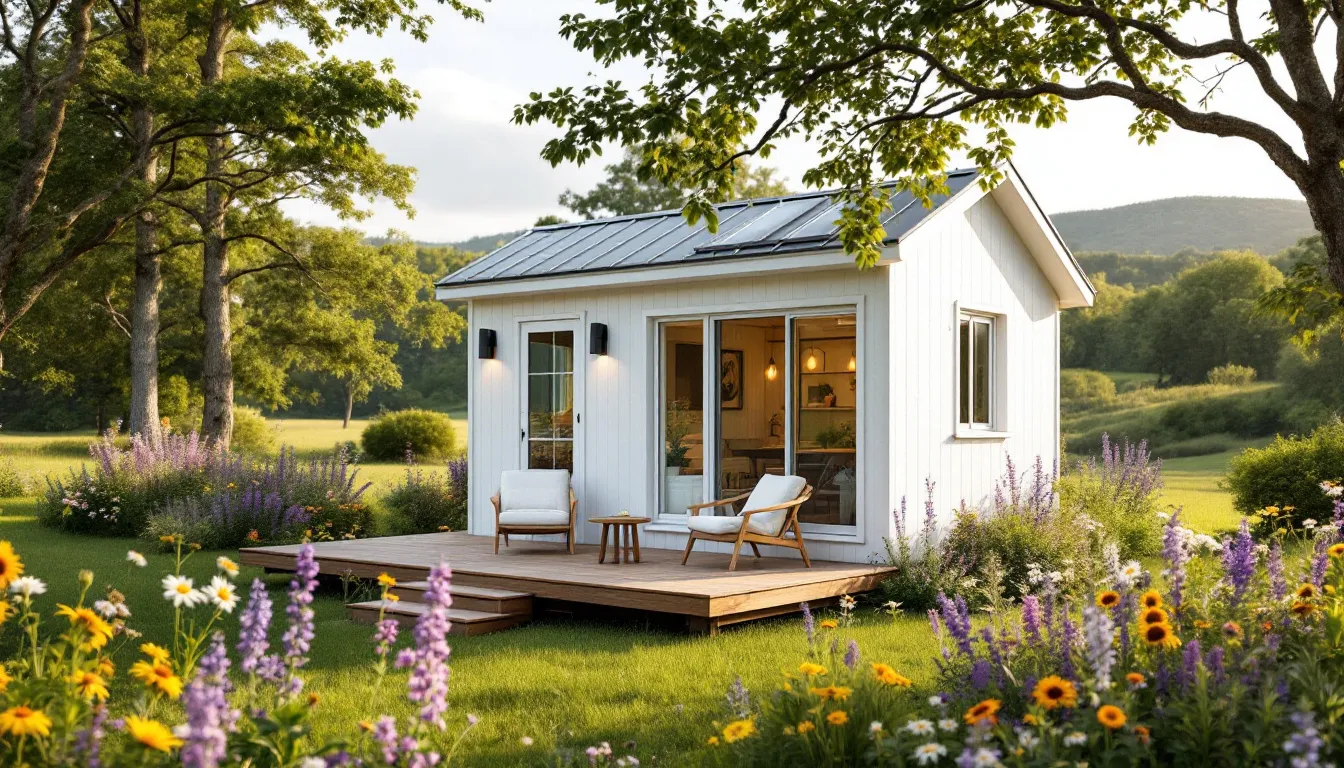Water hammer is a common plumbing issue that can cause loud banging noises and potential damage to pipes. Tiny houses are especially vulnerable due to their compact layouts and shorter plumbing systems.
Key Points:
- What is Water Hammer? A pressure surge caused by the sudden stop or redirection of water flow, often triggered by fast-closing valves (e.g., washing machines).
- Why Tiny Houses Are Affected: Shorter pipes amplify noise and vibrations, and limited space makes fixes harder.
- Risks: Can lead to pipe damage, leaks, or bursts, especially in mobile tiny homes with added movement stress.
- Solutions:
- Install water hammer arrestors near quick-closing valves.
- Use pressure regulators to maintain safe water pressure (30-55 PSI).
- Secure pipes with clamps or straps to reduce movement.
- Opt for flexible PEX piping and vibration-absorbing brackets in mobile setups.
Quick Tip:
Start by checking water pressure and securing loose pipes. For lasting fixes, add water hammer arrestors and pressure regulators to protect your plumbing system.
Main Reasons for Water Hammer in Tiny Houses
High Water Pressure
When water pressure is too high, it can create shockwaves in the plumbing system when the flow stops suddenly. Tiny houses are particularly prone to this because their compact plumbing systems often operate at pressure levels higher than the typical 40-80 PSI. The shorter pipe runs and confined spaces in these homes make the shockwaves from fast-closing valves - like those in washing machines - even more intense [3] [4].
Loose Pipes
Pipes that aren’t properly secured can move and hit surrounding structures during pressure changes, which makes water hammer noise even louder. In mobile tiny houses, the movement during transit can loosen pipe supports further, increasing the risk of damage. The tight construction and limited space in tiny houses make it harder to use standard methods for securing pipes, especially along walls or in cramped areas [1] [3].
Waterlogged Air Chambers
Air chambers in plumbing are designed to absorb shockwaves, but they can fill with water over time, losing their ability to do so. In tiny houses, frequent pressure changes and limited plumbing layouts make this problem worse. With fewer alternative paths for pressure waves to disperse, water hammer noise and potential damage become more pronounced if air chambers aren't functioning properly [1] [4].
| Common Water Hammer Indicators | Impact in Tiny Houses |
|---|---|
| Loud banging noises | Amplified in small, enclosed spaces |
| Pipe vibration | Higher chance of damaging fixtures |
| Pressure fluctuations | Puts extra strain on compact systems |
| Water flow irregularities | Happens more often in mobile setups |
Why Water Hammer Arrestors Are Important
Ways to Prevent and Fix Water Hammer
Water hammer can be a challenge in tiny houses due to their compact plumbing systems. Here are some practical ways to address and prevent this issue.
Add Water Hammer Arrestors
Water hammer arrestors use compressed air to absorb the shock waves that cause banging noises and pipe damage. In tiny houses, where space is tight and pipe runs are shorter, proper placement is key to managing pressure surges. Focus on areas with quick-closing valves like washing machines, kitchen sinks, or the main water line for the best results [1].
| Location | Benefit | Installation Tip |
|---|---|---|
| Near washing machine | Prevents banging during cycle changes | Install within 6 feet of valve |
| Under kitchen sink | Reduces faucet-related shock waves | Mount vertically for best results |
| Main water line | Protects the entire system | Place after the pressure regulator |
Secure Plumbing Pipes
Loose pipes can amplify water hammer noise. Use clamps or straps to secure pipes every few feet and limit movement [3]. Pay special attention to:
- Areas under sinks or near appliances
- Pipes along exterior walls
- Connection points in the system
- Locations exposed to temperature changes
Install Pressure Regulators
A pressure regulator helps stabilize water pressure (ideally between 30-55 psi), which minimizes the risk of water hammer [3]. This is especially useful for tiny houses connected to municipal water supplies. Look for a regulator that fits your plumbing system, is durable for mobile setups, and requires minimal maintenance.
sbb-itb-2ef3f3a
Specific Tips for Tiny House Plumbing
Tiny houses, especially mobile ones, come with their own set of plumbing challenges. Addressing water hammer in these compact spaces requires thoughtful planning and specialized solutions.
Plumbing for Mobile Tiny Houses
When it comes to mobile tiny houses, plumbing systems must handle the constant movement and vibrations during transport. PEX piping is a popular choice here. Its flexibility and durability make it ideal for mobile setups. To further enhance stability, consider using rubber clamps, vibration-absorbing brackets, and quick-disconnect fittings. These additions help the system stay secure and functional while on the move [1].
Space-Saving Plumbing Tools
In a tiny house, every inch of space matters. Compact tools like mini water hammer arrestors, inline pressure regulators, and flexible pipe connectors with shock absorption are excellent options. These tools not only save space but also help in managing water hammer effectively. They work seamlessly with other plumbing solutions to maintain efficiency in a tight layout [3].
Efficient Plumbing Design
A well-thought-out plumbing design can reduce water hammer while optimizing the limited space. Using low-flow fixtures, smaller diameter pipes, and strategically placed water hammer arrestors can make a big difference. These features help stabilize water pressure, cutting down on pressure surges and conserving space at the same time. Plus, they align with water-saving practices, which are often a priority for tiny house living [2][4].
For more detailed advice, check out platforms like TinyHouseSearch.com. They provide resources and connect you with experienced tiny house builders who understand these specific plumbing needs.
Helpful Resources for Tiny House Plumbing
There are several online platforms that offer practical advice on handling water hammer issues in tiny houses. These range from installation tips to troubleshooting guides, making it easier for homeowners to manage their plumbing systems effectively.
SiteOne and Anchor Pumps feature technical guides focused on preventing water hammer, including advice on installing protective devices. Meanwhile, Aqueduct Plumbing Company and Village Plumbing provide expert insights through blogs that share step-by-step solutions to common plumbing challenges.
For tiny house-specific plumbing guidance, Tiny Houses For Sale, Rent, and More connects users with experienced builders and provides resources tailored to the unique needs of compact plumbing systems.
Here’s a quick overview of some key online resources and what they offer:
| Resource | Focus Area | What They Offer |
|---|---|---|
| TinyHouseSearch.com | Tiny House Plumbing | Builder directory and plumbing-specific resources |
| SiteOne | Technical Plumbing | Articles and product suggestions for water hammer fixes |
| Anchor Pumps | Plumbing Equipment | Equipment guides and tips for pressure management |
| Village Plumbing | Maintenance Advice | Troubleshooting and upkeep tips for plumbing systems |
1st Choice Plumbing, Heating and Air Conditioning also provides detailed documentation on water hammer, covering its causes and solutions. This is particularly helpful for tiny house owners who handle their own plumbing maintenance. Their resources include tips on recognizing early signs of water hammer and strategies to prevent it.
Whether you’re learning about water hammer causes or installing preventive tools, these platforms offer the knowledge you need to keep your tiny house plumbing running smoothly. With their help, tiny house owners can design and maintain systems that are effective and durable.
Conclusion
Key Takeaways
Water hammer can cause serious problems in tiny houses, where compact layouts can make the issue more severe. Shorter pipe runs, limited space, and the mobility of tiny homes create unique challenges that require tailored solutions to minimize damage risks.
Here’s what works best for preventing water hammer in tiny houses:
- Pressure control with regulators and water hammer arrestors
- Proper pipe support to keep plumbing secure
- Routine maintenance to catch issues early
- Extra care for mobile tiny homes, like flexible piping and added support
Practical Plumbing Tips
Tackling water hammer in a tiny house doesn’t have to be complicated. Start with these straightforward steps:
- Control Water Pressure: Use pressure regulators and water hammer arrestors, keeping pressure between 30-55 psi.
- Secure Pipes: Regularly inspect and reinforce pipe supports, especially in homes that move.
- Stay On Top of Maintenance: Check plumbing monthly, focusing on pressure and pipe stability.
If your tiny house is mobile, you’ll need to go a step further. Flexible pipes and stronger supports can handle the extra stress from movement, keeping your plumbing in good shape over time.
FAQs
How can you fix water hammer in a house?
To resolve water hammer, you can drain and refill your plumbing system. Start by turning off the water supply, then open the lowest faucet to let the system drain completely. Once done, refill the system to restore the air chambers. For tiny houses, where plumbing is more compact, installing water hammer arrestors near quick-closing valves can help prevent the issue from recurring [1].
Is water hammer a serious plumbing problem?
Yes, water hammer is more than just an annoying noise - it can cause serious damage to plumbing systems. This is especially concerning in tiny houses because:
- Compact plumbing systems are more prone to pressure changes.
- Limited space can make repairs more difficult.
In small spaces like tiny houses, these challenges are magnified, so addressing water hammer quickly is essential [2] [3].
Where should you install a water hammer arrestor?
Water hammer arrestors are most effective when installed near quick-closing valves, such as those on washing machines, dishwashers, or at the end of long pipe runs. Their small size makes them ideal for tiny houses, where space-saving solutions are key to managing pressure surges efficiently [3] [4].
Understanding these points can help tiny house owners tackle water hammer effectively and protect their plumbing systems.
"Water hammer can lead to serious damage to the plumbing system, including burst pipes, which can cause significant water damage and structural issues in the tiny house. It's crucial to address water hammer promptly to prevent these long-term consequences." [2][4]



